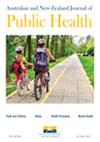在南澳大利亚乳腺筛查中引入乳腺密度通知 - 在线客户调查结果
IF 2.4
3区 医学
Q2 PUBLIC, ENVIRONMENTAL & OCCUPATIONAL HEALTH
Australian and New Zealand Journal of Public Health
Pub Date : 2025-04-12
DOI:10.1016/j.anzjph.2025.100240
引用次数: 0
摘要
目的乳腺密度是乳腺癌风险的最强预测因子之一,并显著降低乳房x光检查对乳腺癌的敏感性。在澳大利亚的筛查项目中,乳腺密度通知正变得越来越普遍。这项机会性研究评估了客户对南澳大利亚乳房筛查中心引入乳腺密度通知的反应,包括他们的理解程度、对通知的批准程度和未来的筛查行为。方法参加三个筛查诊所的患者(N=14,833)由南澳大利亚乳腺筛查中心告知其乳房x线摄影乳房密度,并通过Volpara软件程序测量。乳腺密度分为:a -几乎全脂肪组织,b -分散致密组织,c -非均匀致密组织,d -极度致密组织。结果在5137名受访者(34.6%)中,90%的人支持在该项目中继续报告乳房密度。约三分之二的受访者(65%)认为在做出乳房护理决定时需要知情,几乎所有受访者(98.5%)都打算继续进行乳房筛查。所有受访者中有9%报告了对乳腺密度通知的焦虑(乳腺密度类别A/B为4.5%,C/D为16.6%),14%报告了混淆(乳腺密度类别A/B为10.7%,C/D为19.9%)。所有被通知的妇女都被邀请参加一项后续调查,以评估她们对乳腺密度通知的反应。超过22%的人不知道乳房密度与乳腺癌风险有关,55%的人不确定。结论患者对乳腺密度通知的接受程度较高;然而,人们对相关风险的认识很低。对公共卫生的影响需要更多的新战略,以便更好地与全科医生和客户接触,改善乳房密度教育,并在未来制定个性化筛查方案。本文章由计算机程序翻译,如有差异,请以英文原文为准。
Introduction of breast density notification within BreastScreen South Australia – Results of an online client survey
Objective
Breast density is one of the strongest predictors of breast cancer risk and significantly reduces the sensitivity of mammography to detect breast cancer. Breast density notification is becoming increasingly common within screening programs in Australia. This opportunistic study evaluates client response to the introduction of breast density notification within BreastScreen South Australia, including their level of understanding, approval of notification and future screening behaviours.
Method
Clients attending three screening clinics (N=14,833) were notified by BreastScreen South Australia of their mammographic breast density, measured by the software program Volpara. Breast density was categorised as follows: A-almost entirely fatty tissue, B-scattered dense tissue, C-heterogeneously dense tissue or D-extremely dense tissue.
Results
Of the 5,137 survey respondents (34.6%), 90% supported continued reporting of breast density in the program. Around two-thirds of respondents (65%) felt informed to make decisions regarding their breast care and nearly all (98.5%) intended to continue breast screening. Anxiety in response to breast density notification was reported by 9% of all respondents (4.5% with breast density categories A/B vs 16.6% with categories C/D) and 14% reported confusion (10.7% with breast density categories A/B vs 19.9% with categories C/D). All notified women were and invited to participate in a follow-up survey to assess their response to breast density notification. Over 22% did not know breast density is associated with breast cancer risk and 55% were unsure.
Conclusion
Breast density notification was well received by most clients; however, knowledge about associated risk is considered low.
Implications for Public Health
Additional new strategies are required to better engage with general practitioners and clients, to improve breast density education and to develop a personalised screening program in the future.
求助全文
通过发布文献求助,成功后即可免费获取论文全文。
去求助
来源期刊

Australian and New Zealand Journal of Public Health
医学-公共卫生、环境卫生与职业卫生
CiteScore
4.20
自引率
5.70%
发文量
121
审稿时长
6-12 weeks
期刊介绍:
The Australian and New Zealand Journal of Public Health (ANZJPH) is concerned with public health issues. The research reported includes formal epidemiological inquiries into the correlates and causes of diseases and health-related behaviour, analyses of public policy affecting health and disease, and detailed studies of the cultures and social structures within which health and illness exist. The Journal is multidisciplinary and aims to publish methodologically sound research from any of the academic disciplines that constitute public health.
 求助内容:
求助内容: 应助结果提醒方式:
应助结果提醒方式:


